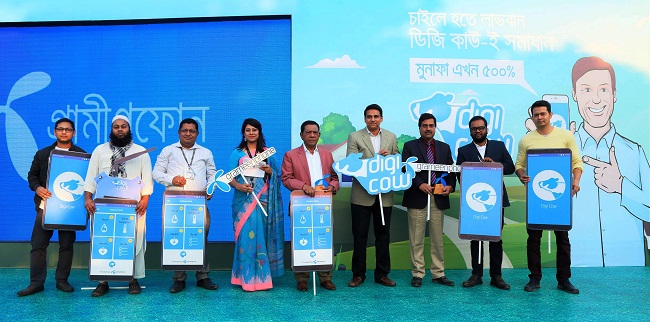The top digital service provider of the country Grameenphone has recently introduced the country’s first IoT-based digital livestock management solution Digi Cow for livestock farmers at Masco Dairy Enterprise, Purbachal. The solution will help farmers digitally monitor livestock health to increase productivity.
Dr. Hiresh Ranjan Voumik, Director General, Department of Livestock Services, was the Chief Guest at the event, while M A Sabur, Group Chairman, MASCO Group were present as special guest. Mahmud Hossain, Chief Business Officer, Solaiman Alam, Head of Digital, and Syed Ashiqur Rahman, Head of Business Innovation, of Grameenphone were also present on the occasion.
The IOT solution was showcased at the event in the presence of the representatives of small and medium cattle farms and large dairy products manufacturers.
The Digi Cow solution consists of an IoT-enabled smart tag. The smart tag, attached to the cow’s body, continuously transmits important data on body temperature, hormonal heat, behavior etc. A mobile app on the user’s smartphone receives a notification on ovulation period or any health anomalies, based on the analysis of the collected data.
Speaking on the occasion Mahmud Hossain, Chief Business Officer, Grameenphone, said, “This is yet another step taken by Grameenphone to enable the society through its core expertise. We will continue working on such innovations which will take benefits of digital technology to the people of this country”
In Bangladesh, 46% of the households possess bovine animals and 20% of the population earns their livelihood completely through livestock. Livestock farmers of this country have already started generating crossbreed cows through artificial insemination since the 1980s. The major challenge in the process was identifying the hormonal heat time of the cow. On several instances, the hormonal heat period is missed, which amounts to a loss of BDT 13,000 per heat missed. Also, there is no way for early detection of any health anomaly in cows. There is a 5.6% mortality rate of these cows in Bangladesh.
Using this solution, farmer’s income and productivity of cows will increase, mortality risk will decrease, and farm management will become easier.

